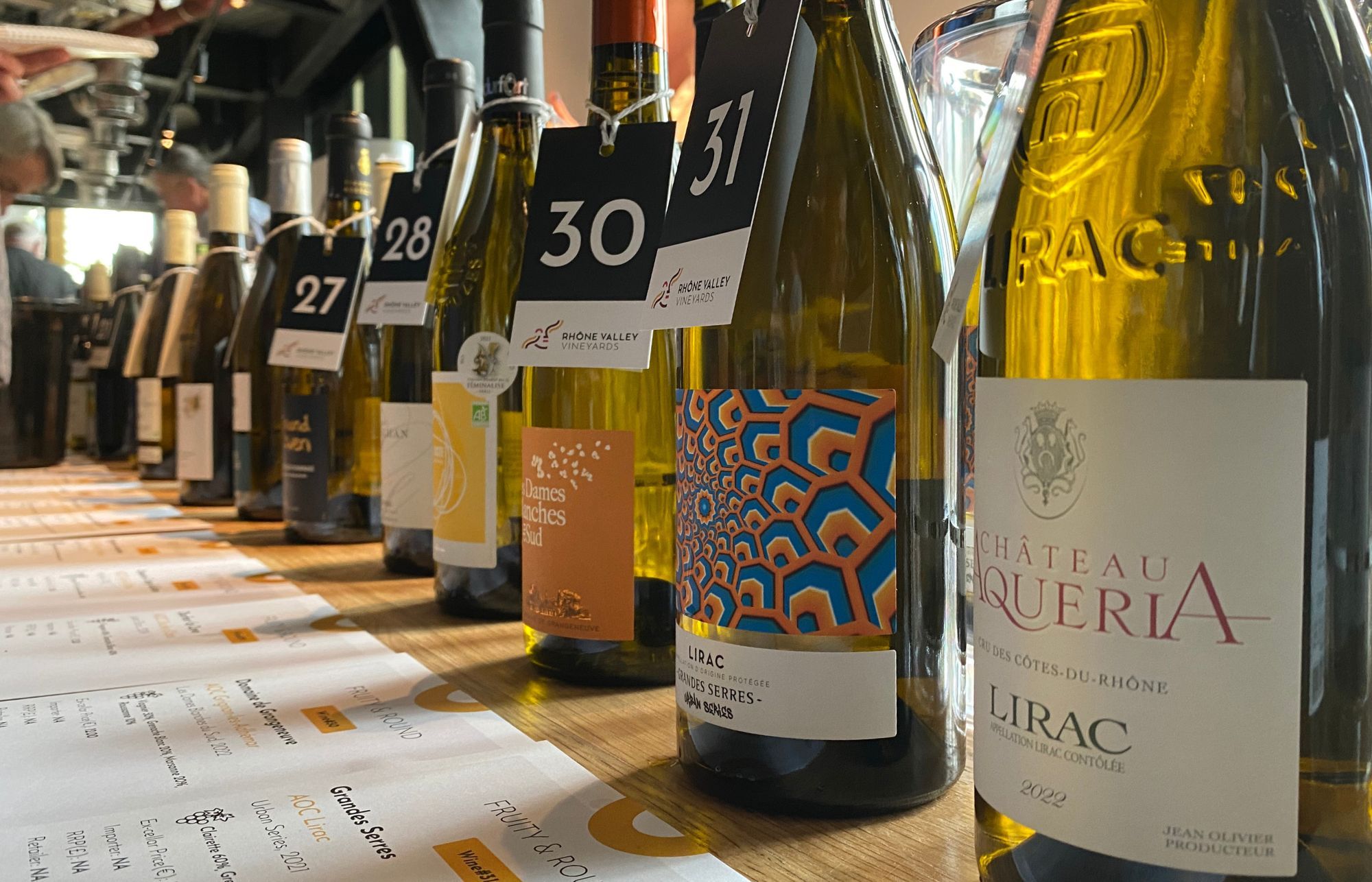“10 years ago, when we started, we were one of the first estates producing white wines, these days I believe more than half of the producers of Vacqueyras produce a still white wine,” says winemaker Philippe Bernard about the rise in Rhône white wines.
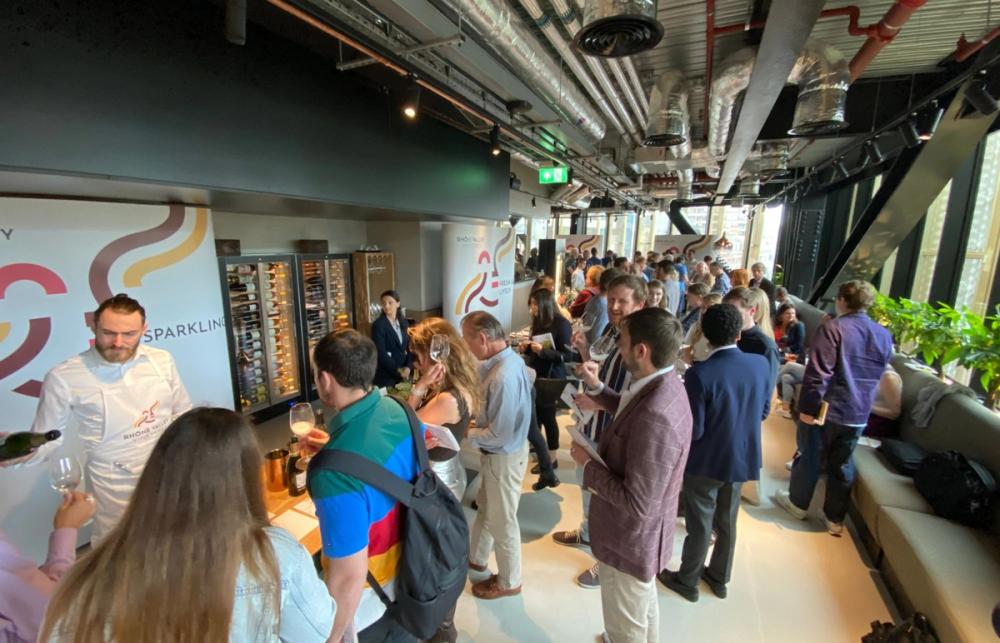
Excited punters at Rhône White Party
The first time I went to the Rhône Valley, it was the Rhône white wines that really stole the show for me. I was lucky enough to report on the Inter Rhône conference in the Spring of 2019, held at the Papal Palace in Avignon. Just walking up the winding stone staircases evoked thoughts of the time of the French Papacy that brought such fame and expansion to the region. Whilst surrounded by the reds from the likes of Hermitage, Côte-Rôtie and Châteauneuf-du-Pape, I ended up searching out the best of the Grenache Blancs, Clairettes and Viogniers egged on by masterclasses from the likes of Andrew Jefford and Matt Walls.
The white wines are not what either the Northern or Southern Rhône is famous for in the modern world. It was the red wines of Hermitage and Côte-Rôtie that caught the attention of the wine press and further international acclaim from the 1980s onwards. The likes of Saint-Joseph and Crozes-Hermitage expanded to increase production. The number of named Côtes du Rhône villages expanded too, along with the focus on quality and consumer demand. All of a sudden the average wine lover in the world knew where Vacqueyras and Gigondas were. And we, as the red wine loving consumers, have been very lucky indeed.
In the background, however, going almost unnoticed over the past few years, has been a quiet revolution in the vineyards. The white wines of the Rhône Valley have been making a come back. That’s not to say they ever truly went away, but the scramble to produce enough red wines to fill demand saw white wine production drop into the mid-single digits just over a decade ago. But, with an average 6% growth in production year on year since 2018, compared to a drop for both reds and rosés, has seen the Rhône Valley white wine harvest hit 11% of all grapes by 2022, with no slowing down in sight.
What do we know about Rhône whites?
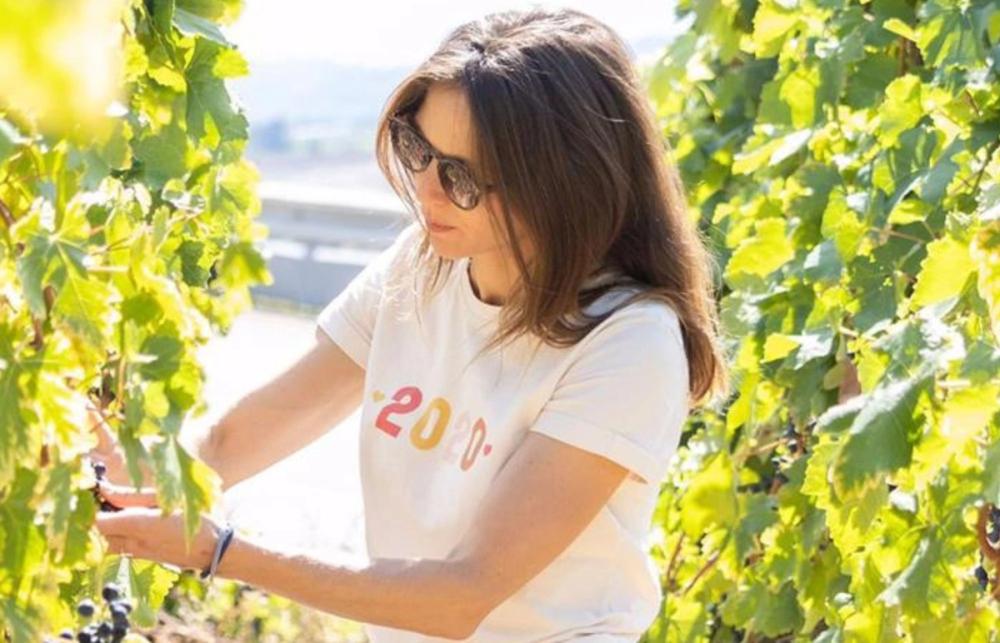
Paul Jaboulet Aîné’s Caroline Frey: doubling production of its St Péray white
There are certain appellations across the Northern and Southern Rhône that have made their name by producing world class white wines. The obvious place to begin is Condrieu. Pretty much at the far north of the vineyard area, this small AOC of barely 200 hectares, including the famed 3.5 hectare plot of Château Grillet, is arguably responsible for saving Viognier as a grape variety as plantings plummeted in the face of poor yields and difficult harvests. These steep, south-facing slopes overlooking the river can produce some of the finest white wines in France.
Also in the Northern Rhône is the slightly-under-the-radar cru of St Péray. Caroline Frey, the celebrated winemaker at the iconic Paul Jaboulet Aîné, revealed the unexpected history of one of the Northern Rhône’s most under-rated regions.
“It’s often nicknamed the Chablis of the Northern Rhône due to its limestone-granite terroir bringing incredible finesse,” explained Frey. “Historically it was a big region for sparkling wines, although these days it’s 85% still white wines, mostly from Marsanne and Roussanne. Our St Péray Les Sauvagères is selling incredibly well, so much so that we’re looking to double our production in the short term.”
Most of the rest of the Northern and Southern Rhône appellations have, of course, built their reputation on red wines, but nearly all allow for white wine production. In fact only Cornas, in the Northern Rhône, demands that no white varieties can be planted. The flexibility that the Côtes du Rhône AOC (accounting for nearly 30% of the whites of the Rhône Valley) offers producers is another great advantage for multi-regional and multi-varietal blends.
Although from a low base, white production in red-dominated regions like Vacqueyras is on the rise, from just 2% five years ago, to around 6% in 2022. Philippe Bernard is the winemaker at Château Bois d’Arlène in Vacqueyras. The estate was purchased as recently as 2013 and Bernard has seen a big change in white production in just a short time. “10 years ago, when we started, we were one of the first estates producing white wines,” remembered Bernard. “These days I believe more than half of the producers of Vacqueyras produce a still white wine.” This year’s Vacqueyras Festival, the 50th anniversary of the annual celebration in the old village, will be the first to focus on the whites and rosés of the region.
Which grape varieties are leading the charge?
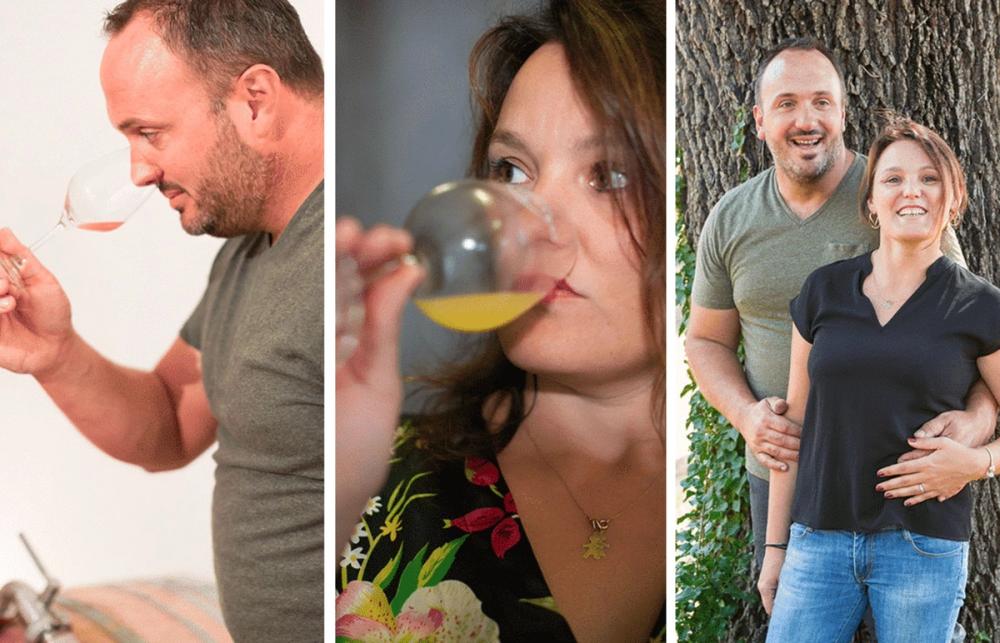
Bois D’Arlène’s Philippe and Elizabeth Bernard: one of the first to produce a white Vacqueyras
The winemakers of the Rhône Valley have up to 12 white grape varieties to choose from. The likes of Grenache Blanc, Viognier, Marsanne, Roussanne, Bourboulenc and Clairette are well known. But other varieties, such as Muscat Blanc à Petits Grains, Vermentino and Folle Blanche (known as Picpoul) add huge depth to the permutations available to skilled growers and blenders.
The actual number depends upon the rules of each individual AOC, but many see this choice as a key strength in the search for unique and sustainable wines in the face of climate change.
“We are certainly one of the wine-growing regions in the world with the greatest diversity of grape varieties, and this is becoming one of our greatest strengths,” stated Denis Alary from Domaine Alary in Cairanne. “At the moment, five or six grape varieties are used predominantly, but others that had long been somewhat forgotten are resurfacing with climate change. Picpoul, for example, thanks to its acidity, will be a prized element in many future blends.”
The decision on which grapes to plant is never set in stone. Château Bois d’Arlène has planted its white varieties to a third each of Roussanne, Viognier and Clairette.
“We like this mix as it allows us to harvest everything at the same time,” revealed Bernard. “The Viognier is usually over ripe and the Clairette is usually under ripe, but together they balance incredibly well. The freshness of Roussanne and Clairette and the fruit from the Viognier is how we see our terroir, and that’s what we want to bottle.”
Climate change, of course, plays a huge part in both current and future planting decisions. Clairette and Bourboulenc are increasingly prized as late ripening varieties that keep a great deal of freshness. Many producers are increasing their plantings of these two, often in favour of previous favourites such as Viognier. “Viognier is suffering a lot from the change in climate,” reflected Bernard. “In 2022 some people were harvesting in the first week of August, and it’s becoming nearly impossible to keep any kind of freshness in those kinds of vintages.”
Some varieties require a lot more patience and understanding. Roussanne can be famed for its freshness and aromatic profile, but grape growers know they’re in for a battle. “Roussanne is like an F1 grape,” mused Bernard. “It can be the best and the worst. It needs some water and some sun, but not too much of either. It’s also sensitive to all kinds of diseases, but when all controlled it makes incredible wines. That’s why we do it!”
What is driving the rise in production?
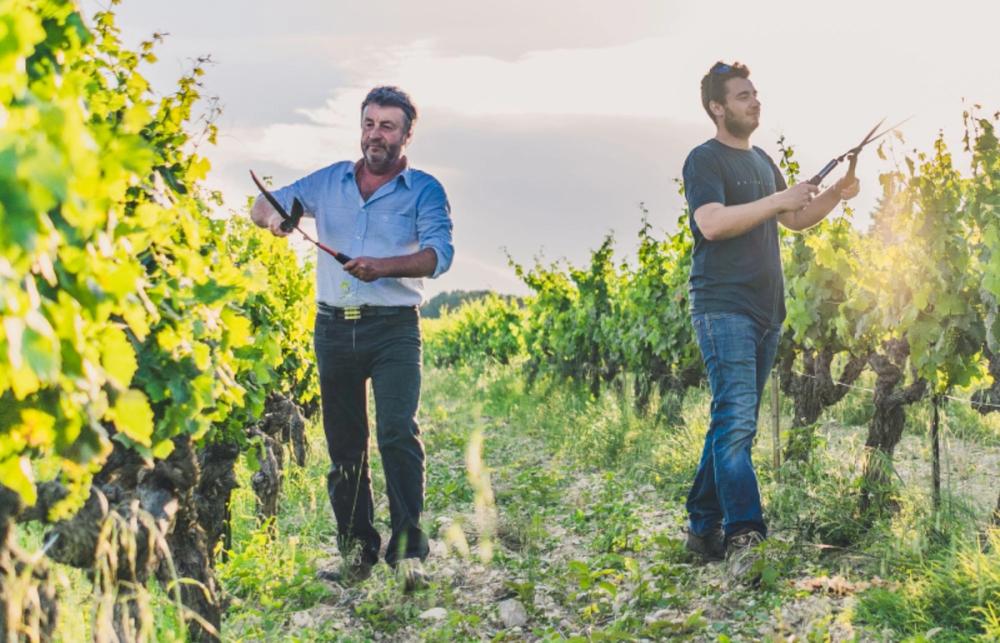
“Picpoul, thanks to its acidity, will be a prized element in many future blends,” says Denis Alary
The market for white wines, both home and abroad, is strong. According to Alary (who is also a leading figure in the Inter Rhône collective of producers) it’s linked to a sharp rise in the consumption of white wines worldwide. He believes this trend is set to continue. “People are looking for fresher, more supple wines and we have to be part of that. It’s why we’re targeting 300,000 hl (around 14% of production) by 2031, which would be year on year growth of over 5%.”
This high demand is putting pressure on the smaller volumes of classic crus. Although this helps to keep margin and quality high, it’s increasingly difficult to satisfy the demand.
“At Jaboulet we’re seeing increasing pressure on the sales of our whites, especially our Condrieu,” revealed Frey. “Condrieu is only 200 hectares and we, ourselves, only make 3,000 bottles of our Les Grands Amandiers which has been on allocation only for a number of years now. Of course, it’s a struggle to satisfy all the wine enthusiasts around the world.”
Even in crus less associated with white production, advances in technology have helped grape growers increasingly understand the terroir at their disposal. Although the ‘garrigue soils’ that cover large areas of the Southern Rhône are difficult for white varieties, research in the last 20 years has revealed a series of outcrops of deep clays, perfect for the white varieties, to flourish. “About 15 years ago there was a huge study done in Vacqueyras as we wanted a geological map of the AOC so we knew what to plant and where,” continued Bernard. “We have garrigue and sandy soils for reds, but then there are these clay soils on north-facing slopes that are perfect for whites. Our own whites are planted on clay soils that reach at least 60m down, which give us incredible freshness.”
This generation of winemakers is also well travelled and has the confidence to experiment with its whites to boost their own portfolios. “It helps that we’ve seen great acceptance by both local and foreign consumers,” noted Bernard. “I don’t have to go for classic Northern Rhône styles or go too oaky. I actually only use my barrels to add a sappiness to increase freshness, otherwise it’s all about my grapes.”
Along with the increase in production comes the support network of the Inter Rhône board and the individual AOCs themselves.
“We are putting in place technical itineraries to develop volumes, as well as a common communication strategy for all the Appellations des Vignobles de la Vallée du Rhône,” revealed Alary. “But it’s a collective approach: the winegrowers who are technically and commercially ready don’t want to miss the boat!”
Why you need Rhône white wines on your list
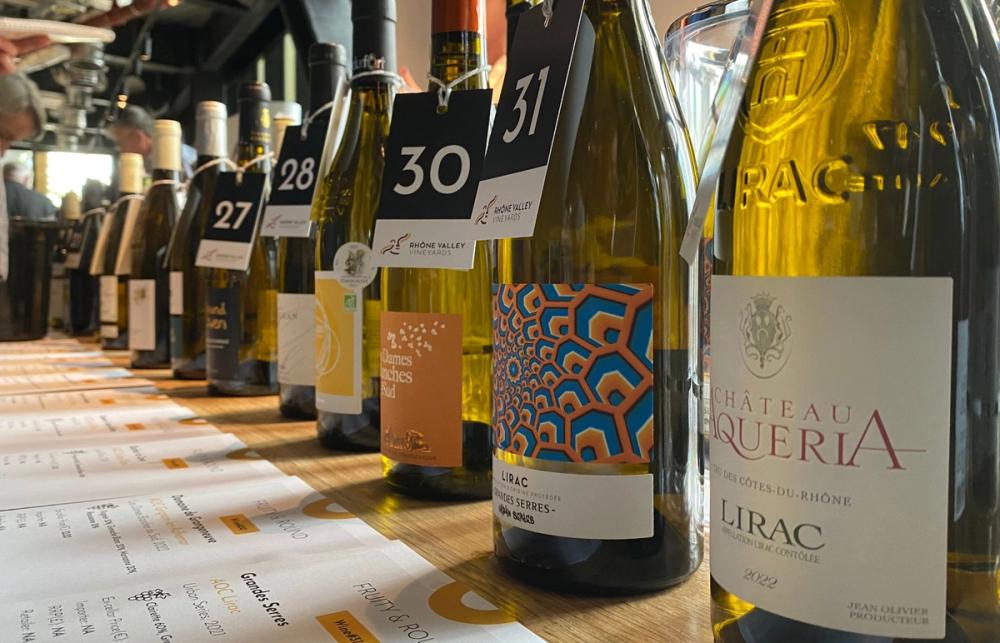
Line-up at this summer’s Rhône White Party in London
The food pairing options of Rhône white wines are the obvious starting point. Whether you’re picking a wine for yourself or for your customers, it’s always handy to have a bottle you know you can go to that will suit a collection of tastes and work with all the different food orders around your table. The flexibility of the Rhône whites were perfectly reflected by the producers themselves.
“For me, I like to go very classic,” pondered Frey. “A glass of our delicious Condrieu Les Grands Amandiers 2020 with Rigotte de Condrieu. What can be better than white wine and cheese, especially when they both come from the same area?”
“Most Rhône whites are fabulous with seafood in general, but for me, it has to Coquilles St Jacques,” enthused Bernard. “Cooked with fat, butter and spices, that blend of roundness and freshness in the wines pair beautifully.”
It’s also a chance to add new, interesting wines to your list that have historically been difficult to import. “Many Rhône whites have been consumed locally, and the small volumes produced have blocked buyers in the past,” explained Alary. “But with production on the rise, as well as the diversity of our white wines, both in terms of appellations and grape varieties, we think importers can have the confidence to increase their demand for white wines from the Rhône Valley.
10 of the best from the Rhône White Party
Earlier this summer, Inter Rhône arrived in London with itsRhône White Party, showcasing over 100 white wines from across the appellations of the Northern and Southern Rhône. Split into categories such as “Rich & Complex”, “Fruity & Round” and “Fresh & Lively”, this was a fabulous opportunity to explore the diversity on show from the white wines of the region. Here are a just a handful to look out for in the future:
Style: FRESH & LIVELY

Maison Sinnae, AOC Côtes du Rhône, Enfant Terrible 2022
Blend of five varieties led by Grenache Blanc and Clairette, that does exactly what is says on the MO. It’s fresh and lively with lovely green, stone and citrus fruits and something beautifully savoury and mineral on the finish to add some bite. Sounds daft, but the label’s pretty eye catching too! Enotria & Co, RRP £12
Château de Manissy, AOC Côtes du Rhône, Oracle 2022
One of the first I tried on the day and, although by no means the most complex by a long shot, I was really impressed by its textured, salty and savoury mouthfeel. It’s got your green, stone, herbal and citrus notes to boot, but I thought this was a cracker for the dinner table at any time of year. Amathus Drinks
Domaine de la Mordorée, AOC Lirac, La Reine Des Bois 2022
Another big blend, this time of seven varieties with Grenache Blanc and Clairette taking the lead roles. Soft fruit and blossom with a beautiful waxy lees mouthfeel. Ticking all the boxes of organic, biodynamic and HVE Level 3. Lea & Sandeman, RRP £30
Style: FRUITY & ROUND

Paul Jaboulet Aîné, AOC Condrieu, Les Cassines 2020
Couldn’t really do a top ten without at least one Condrieu making the grade, and the Les Cassines from Paul Jaboulet Aîné won the day with its building levels of fruit, smoke and toast without ever losing the Viognier stone fruit and floral freshness. Named after the small fishermen’s huts on the river, the 100% Viognier vines are 20-30 years old. This is not really a Condrieu to age, but why would you want to? Those aromas are truly lovely. Bibendum
Maison Sinnae, AOC Côtes du Rhône
The second on the list from the impressive Maison Sinnae. HVE Level 3 practices across the production, great fruit and citrus balance from a massive seven-varietal blend of Rhône white grapes, with Grenache Blanc leading the way with 58%. I cannot believe the RRP on this one. If that’s not a typo then this is a complete steal! Enotria & Coe, RRP £11
Héritiers Gambert Cave de Tain, AOC Saint-Joseph, Terre D’Ivoire 2021
From the ever impressive Cave de Tain comes this left bank Northern Rhône white from 100% Marsanne. Peaches, nectarines, apricots, peach blossom, buttery texture, lovely long finish. Would suit nearly any fish or white meat dish you choose to serve. Boutinot
Style: RICH & COMPLEX
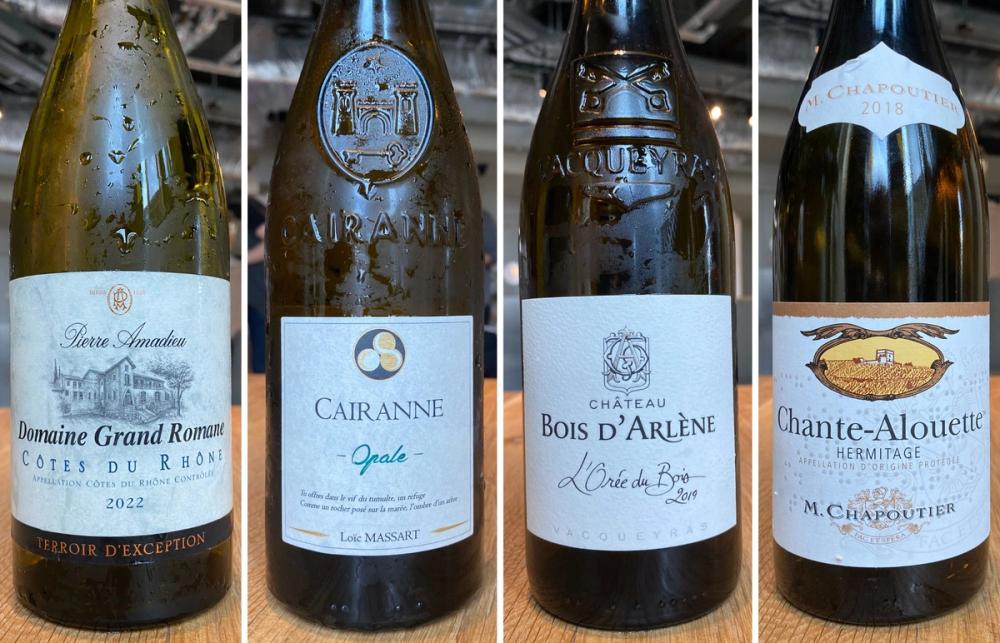
Pierre Amadieu, Domaine Grand Romane, AOC Côtes du Rhône, 2022
100% Clairette in organic conversion. In addition to the lovely green and stone fruits, there’s the added complexity from both herbal and grassy notes as well as a touch of acacia and vanilla. Champagne et Chateaux Ltd, RRP £21
Domaine Les Chemins de Sève, AOC Cairanne, Opale 2021
Organically farmed, this wine comes from a blend of 40% Roussanne, 30% Clairette and 30% Grenache Blanc. Silky texture on the mouth and gloriously rich with honeyed almonds, apricots and a long subtle, but persistent finish. Seeking distribution
Château Bois D’Arlène, AOC Vacqueyras, L’Orée du Bois 2019
This is a blend of a third of each of Roussanne, Clairette and Viognier from organically-certified vineyards covering a mere 0.5 hectares of this 10-hectare estate in the heart of Vacqueyras. A mere 2,000 bottles a year are produced, but still a great fit for a smaller, boutique importer. Stone and citrus fruits, with refreshing citrus flower, the mouth is so luxurious and coating. If the rest of the whites coming out of Vacqueyras taste even close to this then we’re in for a treat! Seeking distribution
M Chapoutier, AOC Hermitage, Chante-Alouette 2018
Another AOC it’s difficult not to mention at least once in a “top wines” selection. 100% Roussanne from three different plots across the hill: Chante-Alouette, Les Murets and Le Méal. Biodynamic certified and sparing use of oak ageing (60% demi muids of which only 10% are new). Full and powerful nose of tropical and stone fruits, lemon, honey, butter, ginger spice and sage, with a subtle nuttiness and smoke on the finish. Delicious as ever. Hatch Mansfield, RRP £65
Further Information
For more information on the Wines of the Rhône Valley or the operations of Inter-Rhone, please contact Lucy Purkis Charters at Sopexa on lpurkis-charters@sopexa.com or head over to https://www.vins-rhone.com/en
Mike Turner is a freelance writer, presenter, educator, judge and regular contributor for The Buyer through his editorial company Please Bring Me My Wine. He also runs a wine events and ecommerce business, Feel Good Grapes, that explores and discusses the idea of sustainability in the wine trade.
